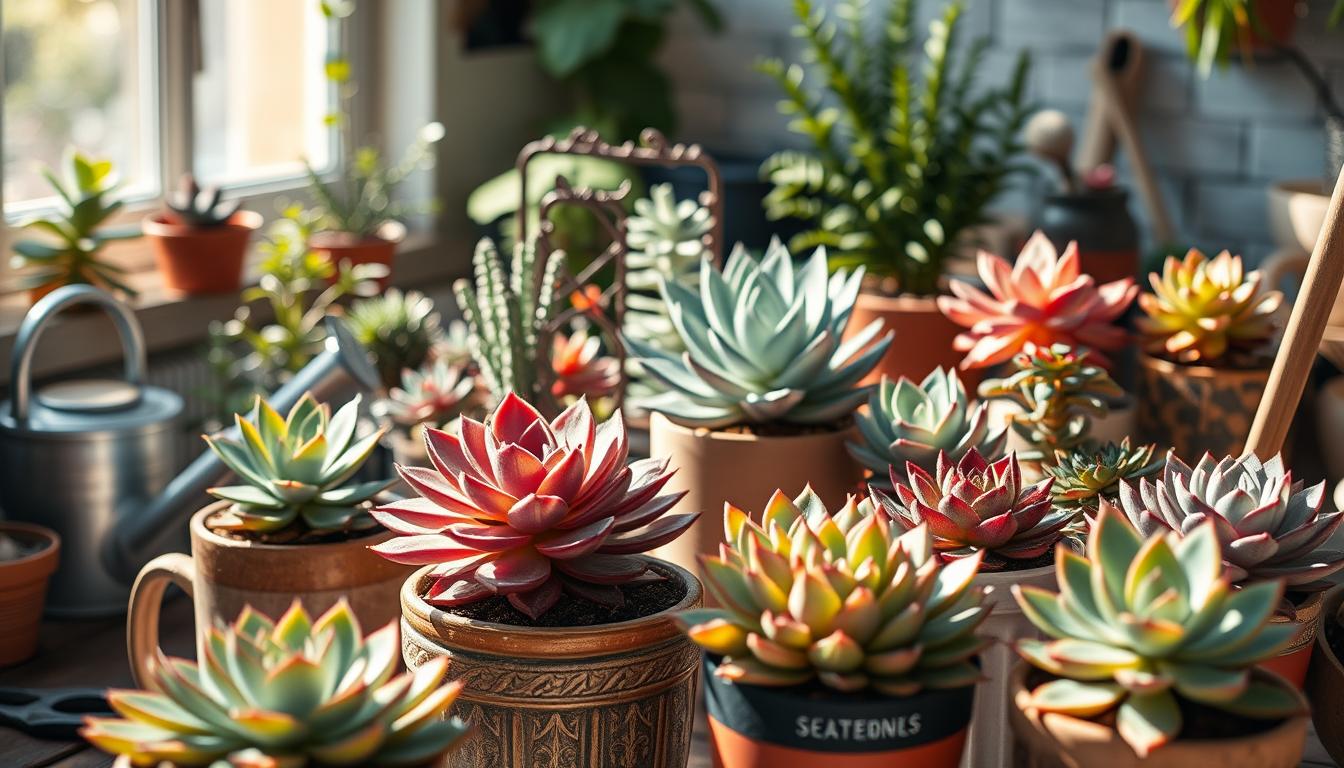I’ve always been fascinated by succulents. I’m excited to share my knowledge with you. If you’re curious about growing succulents, you’re in the right spot. This guide will cover everything you need to know, from picking the right plants to fixing common problems.
Succulents are incredible plants that need very little care. As someone who loves them, I’ve picked up many tips and tricks. This guide is perfect for beginners or those looking to grow more succulents. It’s packed with essential information to help you succeed.
Let’s explore the world of succulents together. I’ll share my experiences and proven methods to help you create a beautiful succulent garden. We’ll go from the basics to advanced care. Get ready for an exciting journey into succulent care!
Understanding Succulents
Succulents are fascinating plants that have captured my heart. They are perfect for both indoor and outdoor spaces. I’ve found them to be easy to care for and incredibly rewarding to grow.
What Are Succulents?
Succulents are unique plants with thick, fleshy parts that store water. This special ability allows them to thrive in dry climates. I love how they come in various shapes, sizes, and colors, making them perfect for any decor style.
Types of Succulents to Consider
There are many succulent varieties to choose from. Here are some of my favorites:
- Echeveria: Known for their rosette shape
- Sedum: Great for ground cover
- Haworthia: Perfect for small spaces
- Aloe: Famous for its healing properties
- Burro’s Tail: Ideal for hanging baskets
Each type has its own unique charm and care requirements. I’ve found that mixing different succulent varieties creates stunning displays.
| Succulent Type | Light Needs | Water Frequency | Growth Rate |
|---|---|---|---|
| Echeveria | Full sun to partial shade | Every 7-10 days | Slow to moderate |
| Sedum | Full sun | Every 7-14 days | Fast |
| Haworthia | Bright indirect light | Every 14-21 days | Slow |
| Aloe | Bright indirect to full sun | Every 14-21 days | Moderate |
| Burro’s Tail | Bright indirect light | Every 10-14 days | Moderate |
Succulents are excellent choices for drought-tolerant landscaping. They add texture and interest to any garden while requiring minimal water. I’ve used them to create beautiful, low-maintenance outdoor spaces that thrive even in dry conditions.
Choosing the Right Container
Finding the perfect pot for your succulents is crucial for their health. I’ve learned this through trial and error. Let’s look at the best options for indoor and outdoor succulents.
Materials for Containers
I’ve tried different materials, each with its own benefits:
- Terracotta: Great for moisture control, ideal for outdoor succulents
- Ceramic: Stylish for indoor succulents, but watch out for water retention
- Plastic: Lightweight and affordable, good for both indoor and outdoor use
Drainage: Why It Matters
Proper drainage is key. I once lost a whole batch of indoor succulents to root rot because of poor drainage. Here’s what I’ve learned:
| Drainage Feature | Importance |
|---|---|
| Holes in container | Prevents water logging |
| Well-draining soil | Allows roots to breathe |
| Elevated pot | Improves air circulation |
Whether you’re growing indoor or outdoor succulents, the right container with proper drainage is essential. I always ensure my pots have drainage holes. I also use a mix of perlite and cactus soil to keep my succulents happy.
The Perfect Soil Mix for Succulents
Discovering the right potting soil for succulents was a big win for me. I learned that the perfect mix is key to keeping these plants healthy. Here’s what I’ve found about creating the best soil for your succulents.
Ingredients for a Great Soil Mix
I’ve tried many mixes and found a great one for succulents. Here’s what’s in my favorite mix:
- 2 parts coarse sand
- 1 part perlite or pumice
- 1 part regular potting soil
This mix drains well but holds enough moisture for succulents. The coarse sand stops water from staying, perlite adds air, and potting soil gives nutrients.
Pre-packaged Soil Options
If you’re short on time, I’ve looked at some pre-made mixes. Here’s how they compare:
| Brand | Drainage | Nutrient Content | Price Range |
|---|---|---|---|
| Bonsai Jack Succulent Soil | Excellent | Moderate | $$$ |
| Miracle-Gro Cactus Mix | Good | High | $ |
| Black Gold Cactus Mix | Very Good | Moderate | $$ |
Whether you make your own or buy a mix, the right soil is crucial. It’s about finding the right balance of drainage and nutrients for your succulents.
Watering Succulents Properly
Learning to water succulents right is key. I’ve found out the hard way that too much water can harm them. Let’s explore how to water succulents just right.
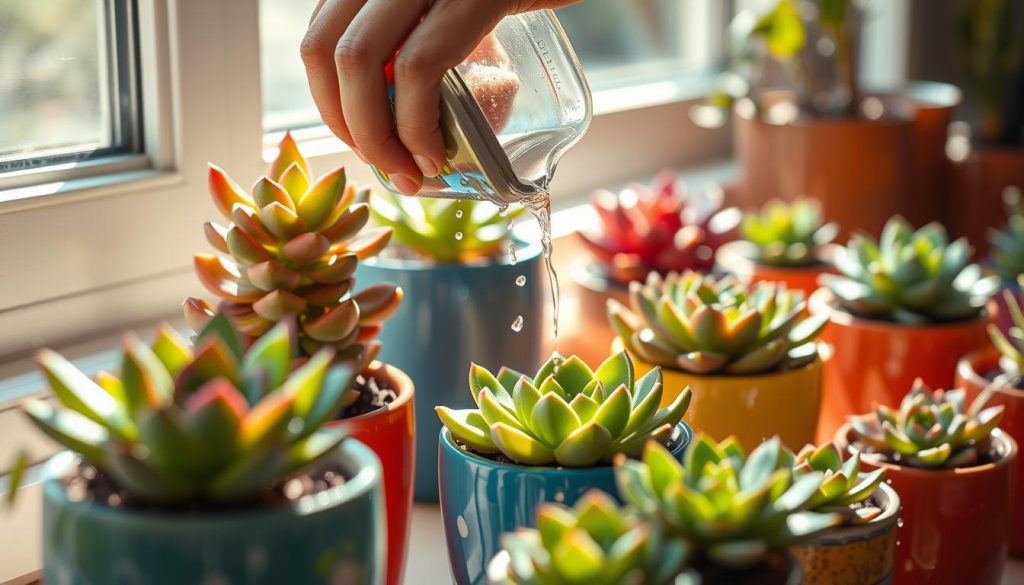
Signs of Overwatering
Overwatering is a common mistake. I look out for these signs:
- Leaves turning yellow or translucent
- Soft, mushy texture
- Black spots on leaves or stem
- Mold on the soil surface
If you see these signs, it’s time to change your watering habits. Succulents do better when they’re a bit dry.
How Often to Water
The “soak and dry” method works well for me. Here’s how I do it:
- Water until it drains from the pot’s bottom
- Let the soil dry completely before watering again
- Check moisture with a wooden skewer or finger
- Adjust how often based on season and environment
In summer, I water every 7-10 days. In winter, it’s once every 3-4 weeks. The climate, pot size, and plant type all affect how often you should water. By watching your plants, you’ll learn what they need.
Ideal Lighting Conditions
Light is key for succulents’ health. Finding the right balance is crucial. Let’s look at the sunlight needs and how to place them for best growth.
Sunlight Needs for Succulents
Most succulents love bright, indirect light. I’ve found 4-6 hours of sunlight daily is perfect for many. Some desert types can take more light, while others prefer the shade.
It’s vital to slowly introduce them to direct sunlight to avoid sunburn. I learned this the hard way!
Indoor vs. Outdoor Placement
For indoor plants, south-facing windows are best. If light is scarce, grow lights can help. Outdoor plants need careful spots too.
I’ve found success with sheltered areas in my garden. They get morning sun but avoid harsh afternoon rays.
| Placement | Light Intensity | Best For |
|---|---|---|
| Indoor – South Window | Bright, Direct | Most succulents |
| Indoor – East Window | Moderate, Indirect | Low-light succulents |
| Outdoor – Partial Shade | Bright, Filtered | Sensitive succulents |
| Outdoor – Full Sun | Intense, Direct | Desert varieties |
Both indoor and outdoor succulents can adjust to different lights with care. Watch for signs like elongated growth or fading colors. Adjust their spot as needed. With the right light, your succulents will thrive and brighten your space.
Feeding Your Succulents
Succulents are known for being easy to care for. But, they still need some attention to grow well. I’ve found that the right fertilizer can really help them thrive. Let’s explore how to feed these beautiful plants.
When and How to Fertilize
I fertilize my succulents in the spring and summer. This is when they grow the most. I’ve learned that a little goes a long way. I use a weak liquid fertilizer once a month, after watering them.
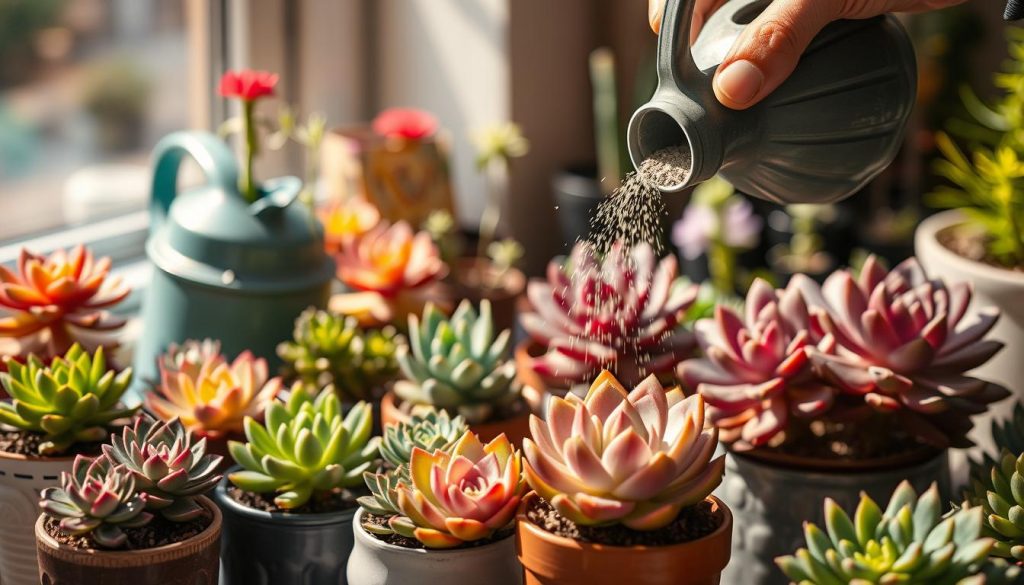
Best Fertilizer Options
For my succulents, I like a balanced fertilizer. It has equal parts nitrogen, phosphorus, and potassium. Here are my top picks:
| Fertilizer Type | Application | Benefits |
|---|---|---|
| Liquid Fertilizer | Monthly during growing season | Easy to control dosage |
| Slow-Release Pellets | Once per growing season | Provides nutrients over time |
| Compost Tea | Bi-monthly during growing season | Natural, organic option |
I’ve had great results with all these fertilizers. But, my favorite is the liquid fertilizer. It’s simple and works well. Succulents are used to growing in poor soil. So, a light touch with fertilizer keeps them healthy and bright.
Repotting Succulents: When and How
Repotting is key for growing succulents. I’ve learned a lot over the years. Now, I’m ready to share my tips with you. Let’s explore when and how to repot your succulents.
Signs That It’s Time to Repot
Your succulent might need a new home if:
– It’s too big for its pot
– The soil looks old or packed
– Roots are showing outside the pot
– Water flows right through without soaking in
Step-by-Step Repotting Process
1. Choose a new pot: Go for one that’s 1-2 inches bigger than the old one.
2. Prepare potting soil: Mix potting soil, coarse sand, and perlite in equal parts.
3. Gently remove the plant: Tap the sides of the old pot to loosen the soil.
4. Inspect and trim roots: Cut off any dead or rotting roots.
5. Place in new pot: Fill halfway with soil mix, put the plant in the center, and add more soil.
6. Water lightly: Let the plant settle in its new home.
Spring or early summer is the best time to repot. This way, your succulents have time to adjust. Remember, good drainage is crucial. With the right soil, water, and care, your succulents will flourish.
Pest Management for Succulents
Keeping succulents healthy is more than just watering and light. Pest control is also key. Even the best plants can get pests.
Common Pests to Watch For
Mealybugs, spider mites, and scale insects are common pests. Mealybugs look like cotton balls and hide in leaf joints. Spider mites create fine webs, and scale insects are small bumps on leaves and stems.
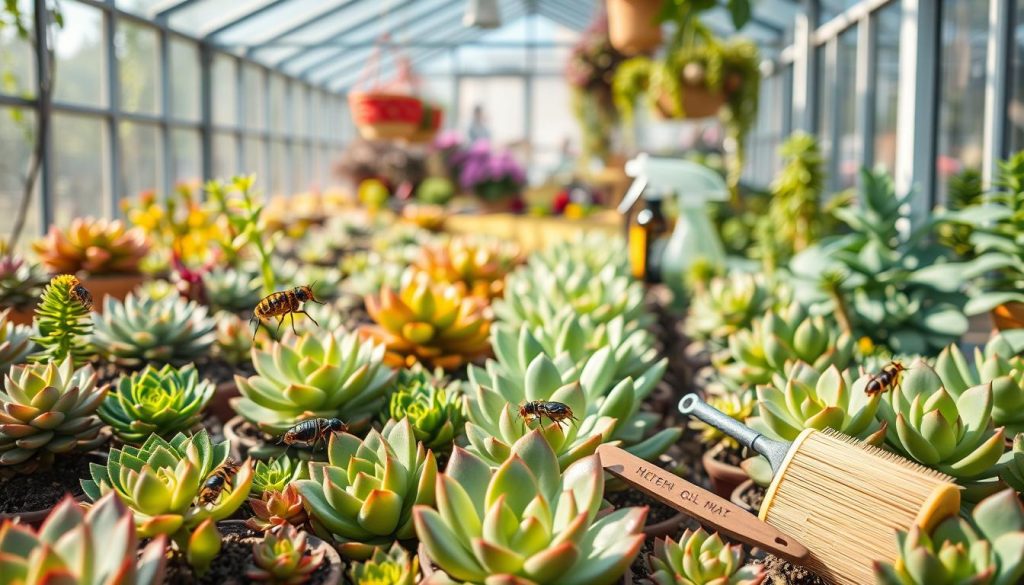
Natural Remedies for Pest Control
I use natural pest control methods. Neem oil is my favorite. It fights many pests and is safe for succulents. I mix a teaspoon of neem oil with a quart of water and spray it every 7-10 days.
Introducing beneficial insects like ladybugs is also helpful. They eat pests without harming plants. For mild infestations, a dish soap and water mix works well.
| Pest | Identification | Natural Control Method |
|---|---|---|
| Mealybugs | White, cottony clusters | Neem oil spray, rubbing alcohol |
| Spider Mites | Fine webbing, tiny specks | Neem oil spray, increased humidity |
| Scale Insects | Small, hard bumps on stems | Neem oil, manual removal |
Prevention is crucial in succulent care. Avoid overwatering and keep air flowing. Regular checks help catch problems early, making pest control easier.
Propagating Succulents
Succulent propagation is a fun way to grow your collection. I love watching new plants sprout from leaves or cuttings. It’s like magic! Let me share my tips on how to grow succulents through propagation.
Leaf vs. Stem Cuttings
There are two main ways to propagate succulents: leaf and stem cuttings. For leaf propagation, gently twist off a healthy leaf. Let it dry for a day, then place it on well-draining soil. Stem cuttings work great for plants like echeveria. Cut a stem, remove lower leaves, let it callous, then plant in soil.
Care for New Plants
Once you’ve started propagating, patience is key. Keep the soil slightly moist but not wet. Place your cuttings in bright, indirect light. After a few weeks, you’ll see tiny roots and new leaves forming. This is when the real excitement begins!
I’ve found that misting works better than watering for new propagations. It prevents overwatering, which can rot your cuttings. As your new succulents grow, gradually increase light exposure and decrease watering frequency. Before you know it, you’ll have a bunch of baby succulents ready to pot up or share with friends.
Succulent propagation has become my favorite way to expand my collection. It’s budget-friendly and so rewarding. Give it a try – you might get hooked like I did!
Seasonal Care Tips
Caring for succulents all year means changing how you care for them with the seasons. I’ve found that these plants need special attention in winter and summer to stay healthy and bright.
Winter Care Essentials
In winter, I protect my succulents from frost and water them less. I move outdoor plants inside or cover them with frost cloth when it gets cold. This helps prevent root rot, a big problem in the cold months.
I only water when the soil is completely dry. This might be once a month for some types.
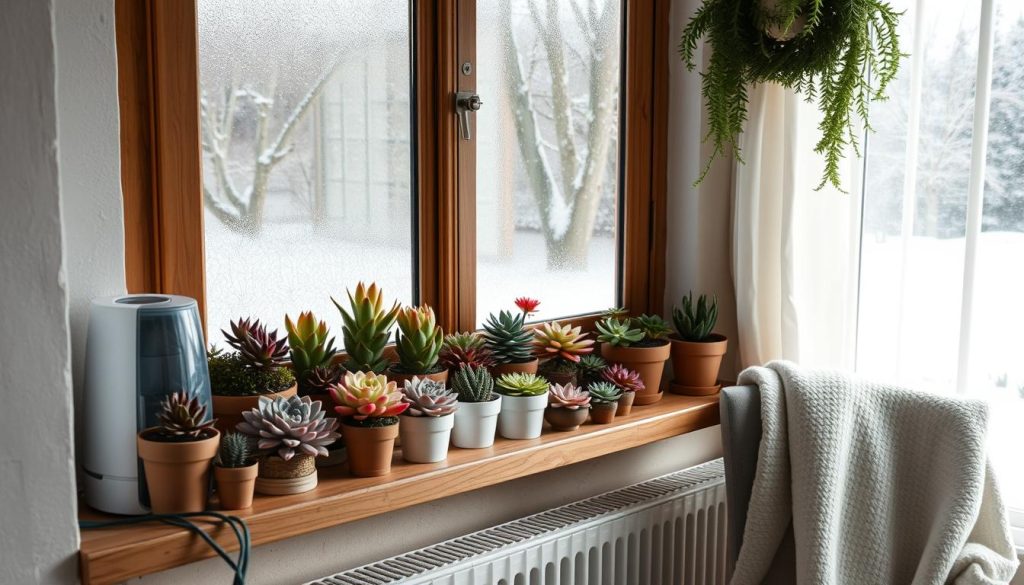
Summer Growth Boosters
Summer is when succulents grow the most. I water them more often but make sure the soil dries out between waterings. For plants outside, I give them shade when it’s hottest to avoid sunburn.
I also feed them a diluted, balanced fertilizer every few weeks. This helps them grow strong and healthy.
- Use well-draining soil to prevent water retention
- Adjust light exposure based on species needs
- Monitor for pests more frequently in warm weather
By adjusting my care routine for each season, my succulents do great all year. Remember, each type of succulent has its own needs. So, it’s key to learn about your plants for the best care.
Troubleshooting Common Issues
Even with the best care, problems can still happen. I’ve dealt with my share of plant troubles. Let’s tackle two common issues: yellowing leaves and shriveling succulents.
Yellowing Leaves: Causes and Solutions
Yellowing leaves often mean you’re watering too much. This is a common mistake. Cutting back on water and improving drainage usually fixes it. Sometimes, yellow leaves also mean your plants need more nutrients.
In these cases, a balanced fertilizer can help. It perks up your plants.
| Cause | Solution |
|---|---|
| Overwatering | Reduce watering frequency, improve drainage |
| Nutrient deficiency | Apply balanced fertilizer |
| Too much direct sunlight | Move to partial shade |
Shriveling Succulents: What It Means
Shriveling can be hard to figure out. But usually, it means your plants need more water. A good soak often fixes it.
But watch out for overwatering. If the soil stays wet, it can cause shriveling. You might need to reduce watering and check for root rot.
Remember, caring for succulents and cacti is all about balance. Water, light, and nutrients are key. By quickly solving these common problems, you’ll keep your plants happy and healthy.
Sharing My Succulent Journey
I’ve fallen in love with succulents. These plants have changed my view on gardening. It all started with a small Jade Plant, and now I’m obsessed with many types.
My Favorite Succulent Care Tips
Less is more with succulents. Water them sparingly and give them bright, indirect light. Using well-draining soil and pots with holes is key. These steps have greatly improved my plants’ health.
Lessons Learned Along the Way
Growing succulents taught me patience and observation. I’ve made mistakes, like overwatering, but each one was a lesson. Now, I watch for signs like yellowing leaves to adjust my care.
If you’re new to succulents, start with Echeveria or Sedum. They’re easy to care for and great for beginners. As you get more confident, try unique types like Living Stones. Each succulent is special, so enjoy learning about them!

